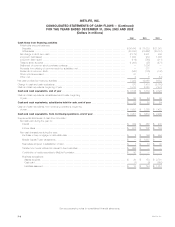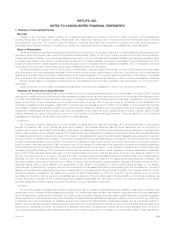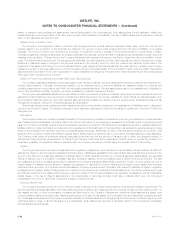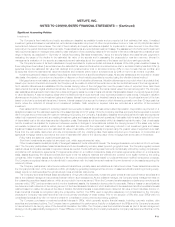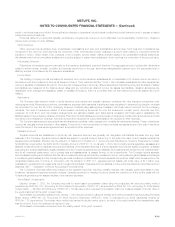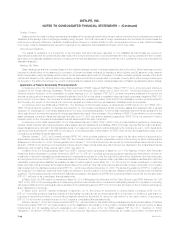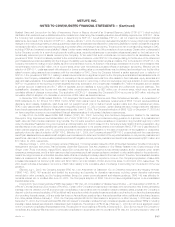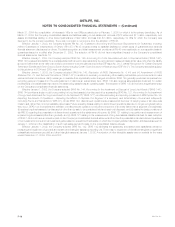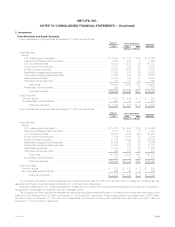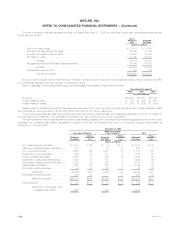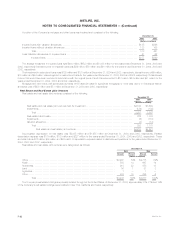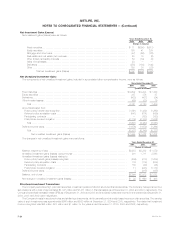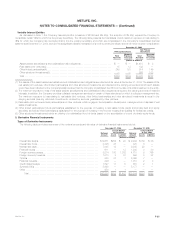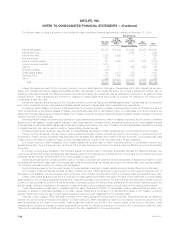MetLife 2004 Annual Report Download - page 60
Download and view the complete annual report
Please find page 60 of the 2004 MetLife annual report below. You can navigate through the pages in the report by either clicking on the pages listed below, or by using the keyword search tool below to find specific information within the annual report.METLIFE, INC.
NOTES TO CONSOLIDATED FINANCIAL STATEMENTS — (Continued)
Realized Gains and Losses from the Sale of Investments, Permit or Require Accrual of an Unearned Revenue Liability (‘‘FSP 97-1’’) which included
clarification that unearned revenue liabilities should be considered in determining the necessary insurance benefit liability required under SOP 03-1. Since
the Company had considered unearned revenue in determining its SOP 03-1 benefit liabilities, FSP 97-1 did not impact its consolidated financial
statements. As a result of the adoption of SOP 03-1, effective January 1, 2004, the Company decreased the liability for future policyholder benefits for
changes in the methodology relating to various guaranteed death and annuitization benefits and for determining liabilities for certain universal life insurance
contracts by $4 million, which has been reported as a cumulative effect of a change in accounting. This amount is net of corresponding changes in DAC,
including VOBA and unearned revenue liability (‘‘offsets’’) under certain variable annuity and life contracts and income taxes. Certain other contracts sold
by the Company provide for a return through periodic crediting rates, surrender adjustments or termination adjustments based on the total return of a
contractually referenced pool of assets owned by the Company. To the extent that such contracts are not accounted for as derivatives under the
provisions of SFAS 133 and not already credited to the contract account balance, under SOP 03-1 the change relating to the fair value of the referenced
pool of assets is recorded as a liability with the change in the liability recorded as policyholder benefits and claims. Prior to the adoption of SOP 03-1, the
Company recorded the change in such liability as other comprehensive income. At adoption, this change decreased net income and increased other
comprehensive income by $63 million, net of income taxes, which were recorded as cumulative effects of changes in accounting. Effective with the
adoption of SOP 03-1, costs associated with enhanced or bonus crediting rates to contractholders must be deferred and amortized over the life of the
related contract using assumptions consistent with the amortization of DAC. Since the Company followed a similar approach prior to adoption of
SOP 03-1, the provisions of SOP 03-1 relating to sales inducements had no significant impact on the Company’s consolidated financial statements. At
adoption, the Company reclassified $155 million of ownership in its own separate accounts from other assets to fixed maturities, equity securities and
cash and cash equivalents. This reclassification had no significant impact on net income or other comprehensive income at adoption. In accordance with
SOP 03-1’s guidance for the reporting of certain separate accounts, at adoption, the Company also reclassified $1.7 billion of separate account assets
to general account investments and $1.7 billion of separate account liabilities to future policy benefits and policyholder account balances. This
reclassification decreased net income and increased other comprehensive income by $27 million, net of income taxes, which were reported as
cumulative effects of changes in accounting. The application of SOP 03-1 decreased the Company’s 2004 net income by $67 million, including the
cumulative effect of adoption of a decrease in net income of $86 million as described above.
In December 2003, FASB revised SFAS No. 132, Employers’ Disclosures about Pensions and Other Postretirement Benefits — an Amendment of
FASB Statements No. 87, 88 and 106 (‘‘SFAS 132(r)’’). SFAS 132(r) retains most of the disclosure requirements of SFAS 132 and requires additional
disclosure about assets, obligations, cash flows and net periodic benefit cost of defined benefit pension plans and other postretirement plans.
SFAS 132(r) was primarily effective for fiscal years ending after December 15, 2003; however, certain disclosures about foreign plans and estimated
future benefit payments were effective for fiscal years ending after June 15, 2004. The Company’s adoption of SFAS 132(r) on December 31, 2003 did
not have a significant impact on its consolidated financial statements since it only revised disclosure requirements.
In May 2004, the FASB issued FASB Staff Position (‘‘FSP’’) No. 106-2, Accounting and Disclosure Requirements Related to the Medicare
Prescription Drug, Improvement and Modernization Act of 2003 (‘‘FSP 106-2’’), which provides accounting guidance to a sponsor of a postretirement
health care plan that provides prescription drug benefits. The Company expects to receive subsidies on prescription drug benefits beginning in 2006
under the Medicare Prescription Drug, Improvement and Modernization Act of 2003 based on the Company’s determination that the prescription drug
benefits offered under certain postretirement plans are actuarially equivalent to the benefits offered under Medicare Part D. FSP 106-2 was effective for
interim periods beginning after June 15, 2004 and provides for either retroactive application to the date of enactment of the legislation or prospective
application from the date of adoption of FSP 106-2. Effective July 1, 2004, the Company adopted FSP 106-2 prospectively and the postretirement
benefit plan assets and accumulated benefit obligation were remeasured to determine the effect of the expected subsidies on net periodic postretirement
benefit cost. As a result, the accumulated postretirement benefit obligation and net periodic postretirement benefit cost was reduced by $213 million and
$17 million, for 2004, respectively.
Effective October 1, 2003, the Company adopted Statement 133 Implementation Issue No. B36, Embedded Derivatives: Modified Coinsurance
Arrangements and Debt Instruments That Incorporate Credit Risk Exposures That Are Unrelated or Only Partially Related to the Creditworthiness of the
Obligor under Those Instruments (‘‘Issue B36’’). Issue B36 concluded that (i) a company’s funds withheld payable and/or receivable under certain
reinsurance arrangements, and (ii) a debt instrument that incorporates credit risk exposures that are unrelated or only partially related to the creditworthi-
ness of the obligor include an embedded derivative feature that is not clearly and closely related to the host contract. Therefore, the embedded derivative
feature is measured at fair value on the balance sheet and changes in fair value are reported in income. The Company’s application of Issue B36
increased (decreased) net income by $4 million and ($12) million, net of amortization of DAC and income taxes, for 2004 and 2003, respectively. The
2003 impact includes a decrease in net income of $26 million relating to the cumulative effect of a change in accounting from the adoption of the new
guidance.
Effective July 1, 2003, the Company adopted SFAS No. 149, Amendment of Statement 133 on Derivative Instruments and Hedging Activities
(‘‘SFAS 149’’). SFAS 149 amended and clarified the accounting and reporting for derivative instruments, including certain derivative instruments
embedded in other contracts, and for hedging activities. Except for certain previously issued and effective guidance, SFAS 149 was effective for
contracts entered into or modified after June 30, 2003. The Company’s adoption of SFAS 149 did not have a significant impact on its consolidated
financial statements.
During 2003, the Company adopted FASB Interpretation (‘‘FIN’’) No. 46, Consolidation of Variable Interest Entities — An Interpretation of ARB No. 51
(‘‘FIN 46’’), and its December 2003 revision (‘‘FIN 46(r)’’). Certain of the Company’s investments in real estate joint ventures and other limited partnership
interests meet the definition of a VIE and have been consolidated, in accordance with the transition rules and effective dates, because the Company is
deemed to be the primary beneficiary. A VIE is defined as (i) any entity in which the equity investments at risk in such entity do not have the characteristics
of a controlling financial interest, or (ii) any entity that does not have sufficient equity at risk to finance its activities without additional subordinated support
from other parties. Effective February 1, 2003, the Company adopted FIN 46 for VIEs created or acquired on or after February 1, 2003 and, effective
December 31, 2003, the Company adopted FIN 46(r) with respect to interests in entities formerly considered special purpose entities (‘‘SPEs’’), including
interests in asset-backed securities and collateralized debt obligations. The adoption of FIN 46 as of February 1, 2003 did not have a significant impact
on the Company’s consolidated financial statements. The adoption of the provisions of FIN 46(r) at December 31, 2003 did not require the Company to
consolidate any additional VIEs that were not previously consolidated. In accordance with the provisions of FIN 46(r), the Company elected to defer until
MetLife, Inc. F-17



